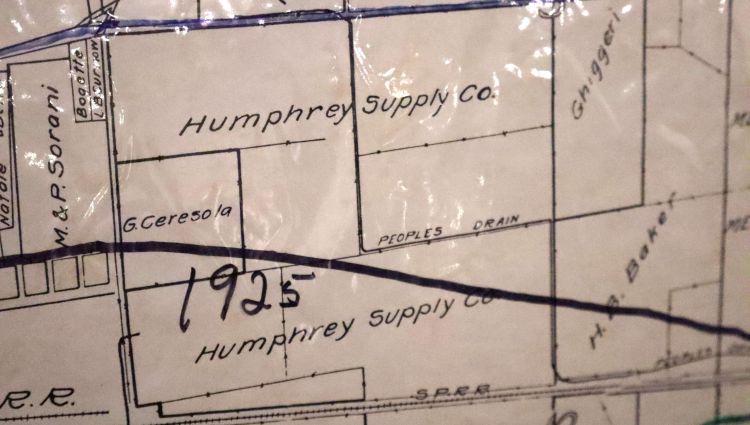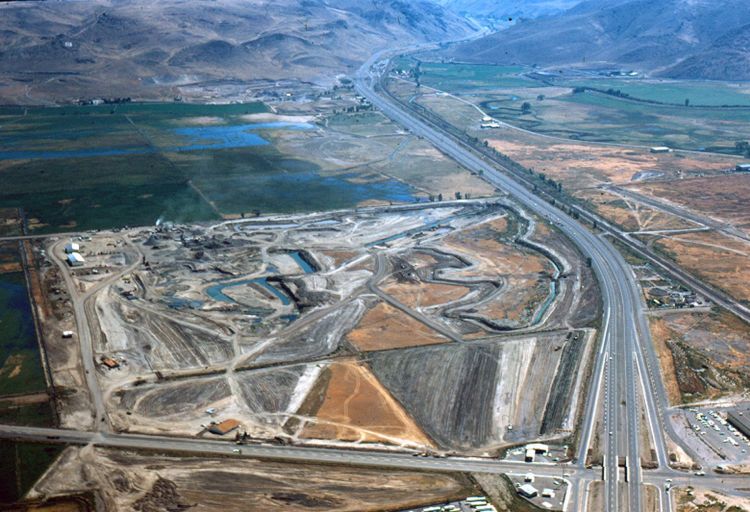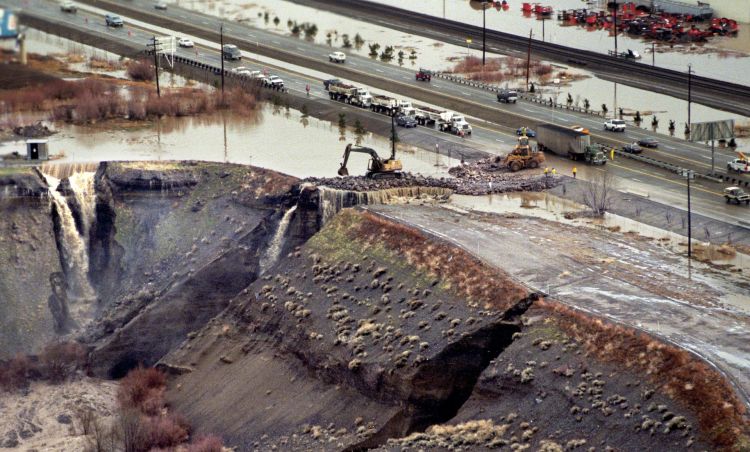Reflections on the Water: A History of the Sparks Marina
By Ariel Van Cleve
November 12, 2025
The Sparks Marina is today a beautiful lake which locals enjoy for recreation and relaxation, but that present reality only scratches the surface of the marina’s significance to the people of northern Nevada. The site’s origins are thoroughly intertwined with two prominent events in Sparks’s history; and over the years, it has contributed to the health and development of our entire region in far more than just recreational ways. To trace the history of the Sparks Marina, however, we begin with its roots in the early twentieth century.
Nichols Ranch
The site of the modern-day Sparks Marina was once property owned by the Humphrey Supply Company and later acquired by its company manager Herbert L. Nichols. However, after Herbert died in 1928, following a riding accident, his son Albert W. Nichols inherited the property. Albert, who graduated in 1930, from what is now the University of Nevada, Reno, worked his father’s land—the Nichols Ranch—as a farmer, rancher, and stockman.
During his career, he used his property to host educational events for fellow cattle ranchers and to help test the compatibility of birdsfoot trefoil legumes with the Truckee Meadows environment for feed.
On December 17, 1958, Albert died of a stroke at the age of 49, leaving the ranch to Ruth, his wife. She kept the ranch in operation but explored opportunities for development on the land. In 1968, the owner of a local construction company proposed to develop a portion of the ranch as a marina, which would require the removal of significant quantities of gravel. In March, the Nevada State Journal reported that, “[Washoe County] Commissioners granted approval to Mrs. Ruth S. Nichols to operate a sand and gravel pit . . . on a portion of the Nichols Ranch, near Sparks.”

Helms Pit
Born 1921, in Klamath Falls, Oregon, Robert L. Helms would become the catalyst for the creation of the Sparks Marina. Leaving Oregon, he wound up in Nevada; and following his service with the army at the end of World War II, Helms went to work as a lineman for the Sierra Pacific Power Company in 1946. In 1951, he struck out on a business venture of his own—the Robert L. Helms Construction and Development Company. His company enjoyed success and would eventually become the largest road construction company in Nevada.
In 1968, Helms received the blessing of the Regional Planning Commission on his proposal to work towards the development of a marina and a special use permit from the Washoe County Board of Adjustment to run a gravel mining operation on the Nichols Ranch.

The open-pit gravel mine which he built and ultimately came to own acquired his namesake, becoming known as Helms Pit.
Materials from this mine were used for local construction. In particular, the development of Interstate-80 represents one prominent project which materials from the Helms Pit supported. During the period of the mine’s operations, “millions of tons of rock” were pulled from Helms Pit, according to Travel Nevada.
An agreement made with the City of Sparks in 1976, which was updated in 1984, established that Helms would transfer ownership of the mine to the city in 1998, at latest—after which time, the city hoped to begin developing the planned marina.
The city limits of Sparks officially expanded to envelop the quarry in 1980.
“Savior of This River”
In 1987, environmental disaster was uncovered in the City of Sparks when the Environmental Protection Agency (EPA) discovered a leak from the Sparks Tank Farm-a local storage site for chemicals. The spill that consisted of between four and forty million gallons of diesel, jet fuel, and solvents, ultimately contaminated Helm’s Pit; for the pit’s depth caused the flow of the spill to divert from the route it would have otherwise taken to the Truckee River had the pit not existed.
Lew Dodgion, the administrator of Nevada’s Department of Environmental Protection, stated in a 1991 Congressional hearing that the spill threatened both the public’s health and wildlife should it reach the Truckee River. In the hearing, Dodgion agreed with Nevada Senator Harry Reid’s characterization of Helms Pit as the “savior of this river at this stage,” and stated himself that, “The problem has erroneously been referred to a lot of times as the Helm’s Pit problem. The Helm’s Pit is actually a blessing in this particular instance, and part of the solution to the problem at this time.”
Still, in order to keep the pollutants from getting into the Truckee River, up to seven million gallons of fuel-laden water in Helm’s Pit had to be decontaminated and pumped to the Truckee River every day, at the cost of $30,000 every month. This cost was borne by a set of companies—Santa Fe Pacific Pipeline Partners, Southern Pacific Transportation Company, Shell Oil, Time Oil Company, Berry-Hinkley Terminal, Inc., Chevron U.S.A., Texaco Refining and Marketing, Air BP, Unocal Corporation, and Golden Gate Petroleum Company—that the state of Nevada, the Washoe County District Board of Health, the City of Sparks, and private citizens sued to hold liable for the spill.
Helm’s Pit was ultimately labeled an official Toxic Superfund Site. In 1995, several of the companies that were sued made settlements for the disaster—giving Nevada $10 million, the Washoe County District Board of Health $150,000, and the City of Sparks $12.5 million; and in 1996, Robert L. Helms transferred ownership of Helm’s Pit to Sparks, three years after his once prosperous construction company had gone bankrupt.
By the end of 1996, the Reno Gazette-Journal reported that the mine had developed into a wetland wildlife refuge, with a variety of flora and fauna living inside, and that the groundwater entering Helm’s Pit was “free of oil.”
“God Filled It”
The City of Sparks’s still hoped to turn its newly acquired pit into a marina, and they continued to take steps toward the realization of their vision for the former gravel mine. However, the challenge of getting a skeptical Nevada Division of Environmental Protection to permit turning the pit into a lake remained a challenge; and, even if they received the authorization, it was expected that three years would be needed to fill Helm’s Pit with the thirty feet of water anticipated by the city’s plans.
Then came 1997. According to the U.S. Geological Survey (USGS), extremely high levels of snow that fell in the Sierras during December 1996, and the arrival of subtropical rains (or a Pineapple Express) produced extreme flooding in northwestern Nevada in January during what became known as the New Year’s Day Flood of 1997. Water in the Truckee River rose to seventeen feet—washing over its banks, sending 900 million gallons of water into Helm’s Pit in mere days, and pulling a section of Interstate-80’s shoulder into the new waterbody.
The mine sustained about $11 million in damages, requiring stabilization and structural repair. Nevertheless, the city had its lake; and after receiving public input, the city changed the name of Helm’s Pit to the “Sparks Marina Park” in December 1997.
The next year Nevada’s Department of Wildlife (NDOW) stocked the Sparks Marina with brown and rainbow trout; and after it first opened on a temporary basis April 1, 1999, the marina became an immediate success with locals for fishing and recreation.
The marina closed once more in July so the city could continue its development of the site, but it reopened the next spring; and on October 5, 2000, Sparks held an official grand opening ceremony for the new Sparks Marina Park.

According to a report in the Reno Gazette-Journal, one of the ceremony’s guest speakers, developer David Dahl, described the Sparks Marina’s creation by saying that “man dug a hole and God filled it.”
Phantom of the Marina
The Sparks Marina’s development continued when diver Kevin Schwartz donated his out-of-service RF-4C Phantom fighter jet to help turn it into a diving park.
The Phantom, which flew tactical reconnaissance missions during the Vietnam War, later served in the Nevada Air National Guard’s 192nd Tactical Reconnaissance Squadron (“High Rollers”) from 1975 until April 27, 1988, when its pilot R.J. Bath and his weapon system officer were forced to eject from the aircraft following a hydraulics failure. The plane’s crash landing ended its career in the skies, and the jet was subsequently made a training prop at Stead before coming into Schwartz’s possession.
In July 2001, the RF-4C Phantom—which had been cleaned, gutted, and slightly modified for its new role as a park attraction—was airlifted to the marina and lowered in its waters to a depth of sixty feet during the city’s Star-Spangled Sparks festivities. Ideas to place more items in the marina for divers fizzled, however; and the Phantom remains the only attraction to haunt divers beneath the waters of the marina today.
Development & Environmental Challenges
The remaining history of the Sparks Marina Park in the twenty-first century is primarily a story of community, interrupted only by further development and a few environmental challenges.
By 2002, the shallow layer of sand around the marina’s northern swimming area had grown hardened; and, in June, over one hundred truckloads of sand from Lake Tahoe were imported to increase the depth of the beach there by several inches. Later, in April and May 2004, the city sprayed the marina water with 1,000 gallons of a debris-eating bacteria product called Enviro-Culture to improve the water’s clarity.
In addition to these improvements, the city’s placed volleyball courts, a pier, fish cleaning stations, and more around the marina.
However, during the winters of 2013 through 2015, fish in the Sparks Marina suffered turbulent times. During these years, the marina’s waters kept experiencing turnover—a phenomenon in which the marina’s oxygenated upper layer of water would combine with the oxygen-deficient groundwaters below it, diluting oxygen levels and suffocating fish.
The most severe of these winter-time turnovers killed the marina’s entire population of about 100,000 fish in the 2013-14 season. Nevertheless, the marina continued to be stocked with fish by the Nevada Department of Wildlife (NDOW) for angling outside the winter months; and fewer fish died during subsequent turnovers.
Sparks Marina Park
Today, the Sparks Marina Park stands in the heart of modern-day Sparks as a 120-foot-deep natural aquifer, filled with approximately one billion gallons of water and covering an expanse of 77-acres.
The lake also serves as a fishery that NDOW stocks with channel catfish, smallmouth bass, and several varieties of trout; and locals continue to visit the marina for fishing and other, various types of recreation.
Since its grand opening near the turn of the century, the Sparks Marina Park has become a popular site for holiday celebrations, fundraisers, concerts, and sports, too. Celebrations of America’s independence, Thanksgiving Turkey Trot races, Hydro-Turf Watercross National Tour competitions, and many more events have been hosted there over the years.
Professional wakeboarding came to town as early as 2004, after the MasterCraft Pro Wakeboard Tour made the Sparks Marina its third destination in their competition series. Since then, the marina has been home to a number of prominent wakeboarding competitions, including both national and world championship events.
Now, the Sparks Marina Park is poised to continue providing locals with beauty and respite well into the future, at their very own oasis in northern Nevada’s desert landscape.

